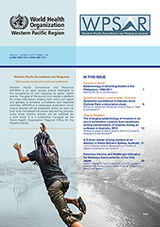The changing epidemiology of measles in an era of elimination: lessons from health-care-setting transmissions of measles during an outbreak in New South Wales, Australia, 2012
DOI:
https://doi.org/10.5365/wpsar.2016.7.1.010Abstract
Introduction: In countries where measles is rare, health-care-setting transmissions remain problematic. Australia experienced its largest measles outbreak in 15 years in 2012 with 199 cases reported nationally; 170 cases occurred in the state of New South Wales (NSW) with symptom onset between 7 April and 29 November 2012.
Methods: A descriptive study was conducted using measles case data obtained from metropolitan Sydney local health districts in NSW in 2012. Characteristics of measles source and secondary cases were described. Details of health-care presentations resulting and not resulting in measles transmission were also analysed.
Results: There were 168 confirmed and two probable cases resulting in 405 documented health-care presentations. Thirty-four secondary cases acquired in health-care settings were identified, including 29 cases resulting from 14 source cases and 5 cases whose source could not be identified. Health-care-acquired cases accounted for 20% of all cases in this outbreak. Source cases were more likely to be of Pacific Islander descent (P = 0.009) and to have had more presentations before diagnosis (P = 0.012) compared to other cases. The percentage of presentations to emergency departments was higher for presentations that resulted in transmission compared to those that did not (71.4% and 37.6%, respectively, P = 0.028). There were no significant differences between transmission and non-transmission presentations with respect to presence of rash and infection control measures (P = 0.762 and P = 0.221, respectively), although the power to detect these differences was limited. Rash was reported at 66% of the presentations.
Conclusion: Development of and adherence to protocols for the management of patients presenting to hospitals with fever and rash will minimize secondary transmission of measles.

